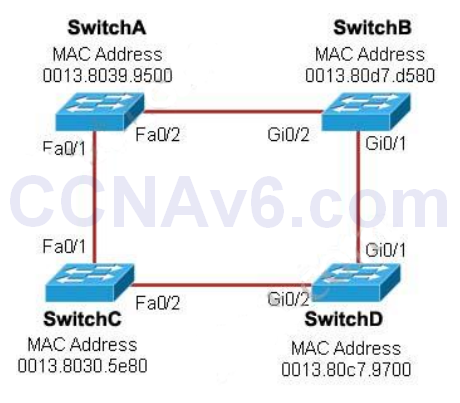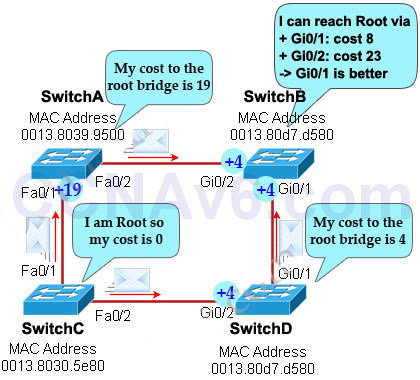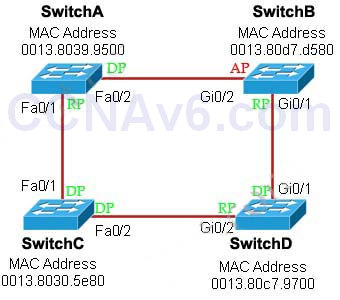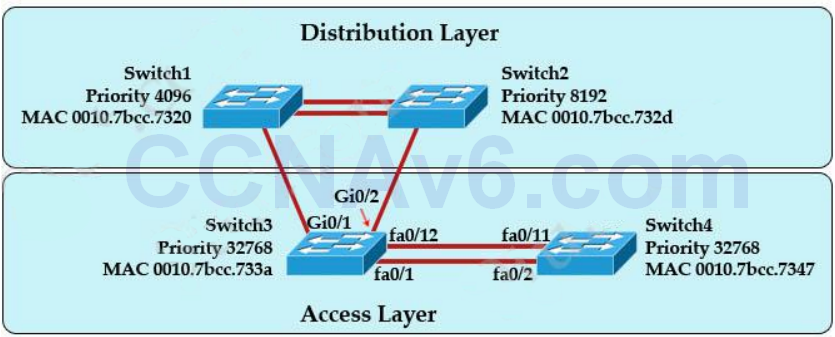- Which two spanning-tree port states does RSTP combine to allow faster convergence? (Choose two)
- A. discarding
- B. listening*
- C. blocking*
- D. forwarding
- E. learning
Show (Hide) Explanation/ReferenceThere are only three port states left in RSTP that correspond to the three possible operational states. The 802.1D blocking, and listening states are merged into the 802.1w discarding state.* Discarding – the port does not forward frames, process received frames, or learn MAC addresses – but it does listen for BPDUs (like the STP blocking state)
* Learning – receives and transmits BPDUs and learns MAC addresses but does not yet forward frames (same as STP).
* Forwarding – receives and sends data, normal operation, learns MAC address, receives and transmits BPDUs (same as STP).STP State (802.1d) RSTP State (802.1w) Blocking Discarding Listening Discarding Learning Learning Forwarding Forwarding Although the learning state is also used in RSTP but it only takes place for a short time as compared to STP. RSTP converges with all ports either in forwarding state or discarding state.
- Refer to the exhibit. Each of these four switches has been configured with a hostname, as well as being configured to run RSTP. No other configuration changes have been made. Which three of these show the correct RSTP port roles for the indicated switches and interfaces? (Choose three)

- A. SwitchA, Fa0/2, designated *
- B. SwitchA, Fa0/1, root *
- C. SwitchB, Gi0/2, root
- D. SwitchB, Gi0/1, designated
- E. SwitchC, Fa0/2, root
- F. SwitchD, Gi0/2, root*
Show (Hide) Explanation/ReferenceThe question says “no other configuration changes have been made” so we can understand these switches have the same bridge priority. Switch C has lowest MAC address so it will become root bridge and 2 of its ports (Fa0/1 & Fa0/2) will be designated ports -> E is incorrect.Because SwitchC is the root bridge so the 2 ports nearest SwitchC on SwitchA (Fa0/1) and SwitchD (Gi0/2) will be root ports -> B and F are correct.
Now we come to the most difficult part of this question: SwitchB must have a root port so which port will it choose? To answer this question we need to know about STP cost and port cost.
In general, “cost” is calculated based on bandwidth of the link. The higher the bandwidth on a link, the lower the value of its cost. Below are the cost values you should memorize:
Link speed Cost 10Mbps 100 100Mbps 19 1 Gbps 4 SwitchB will choose the interface with lower cost to the root bridge as the root port so we must calculate the cost on interface Gi0/1 & Gi0/2 of SwitchB to the root bridge. This can be calculated from the “cost to the root bridge” of each switch because a switch always advertises its cost to the root bridge in its BPDU. The receiving switch will add its local port cost value to the cost in the BPDU.
In the exhibit you also we FastEthernet port is connecting to GigabitEthernet port. In this case GigabitEthernet port will operate as a FastEthernet port so the link can be considered as FastEthernet to FastEthernet connection.
One more thing to notice is that a root bridge always advertises the cost to the root bridge (itself) with an initial value of 0.
Now let’s have a look at the topology again

SwitchC advertises its cost to the root bridge with a value of 0. Switch D adds 19 (the cost value of 100Mbps link although the port on Switch D is GigabitEthernet port) and advertises this value (19) to SwitchB. SwitchB adds 4 (the cost value of 1Gbps link) and learns that it can reach SwitchC via Gi0/1 port with a total cost of 23. The same process happens for SwitchA and SwitchB learns that it can reach SwitchC via Gi0/2 with a total cost of 38 -> Switch B chooses Gi0/1 as its root port -> D is not correct.
Now our last task is to identify the port roles of the ports between SwitchA & SwitchB. It is rather easy as the MAC address of SwitchA is lower than that of SwitchB so Fa0/2 of SwitchA will be designated port while Gi0/2 of SwitchB will be alternative port -> A is correct but C is not correct.
Below summaries all the port roles of these switches:

+ DP: Designated Port (forwarding state)
+ RP: Root Port (forwarding state)
+ AP: Alternative Port (blocking state) - Which two switch states are valid for 802.1w? (Choose two)
- A. listening
- B. backup
- C. disabled
- D. learning*
- E. discarding*
Show (Hide) Explanation/ReferenceIEEE 802.1w is Rapid Spanning Tree Protocol (RSTP). There are only three port states left in RSTP that correspond to the three possible operational states. The 802.1D disabled, blocking, and listening states are merged into the 802.1w discarding state.* Discarding – the port does not forward frames, process received frames, or learn MAC addresses – but it does listen for BPDUs (like the STP blocking state)
* Learning – receives and transmits BPDUs and learns MAC addresses but does not yet forward frames (same as STP).
* Forwarding – receives and sends data, normal operation, learns MAC address, receives and transmits BPDUs (same as STP). - Which two states are the port states when RSTP has converged? (choose two)
- A. discarding*
- B. learning
- C. disabled
- D. forwarding *
- E. listening
Show (Hide) Explanation/ReferenceRSTP only has 3 port states that are discarding, learning and forwarding. When RSTP has converged there are only 2 port states left: discarding and forwarding. - Which three statements about RSTP are true? (choose three)
- A. RSTP significantly reduces topology reconverging time after a link failure. *
- B. RSTP expends the STP port roles by adding the alternate and backup roles. *
- C. RSTP port states are blocking, discarding, learning, or forwarding.
- D. RSTP also uses the STP proposal-agreement sequence.
- E. RSTP use the same timer-based process as STP on point-to-point links.
- F. RSTP provides a faster transition to the forwarding state on point-to-point links than STP does.*
- Which command enables RSTP on a switch?
- A. spanning-tree mode rapid-pvst *
- B. spanning-tree uplinkfast
- C. spanning-tree backbonefast
- D. spanning-tree mode mst
- Which two of these statements regarding RSTP are correct? (Choose two)
- A. RSTP cannot operate with PVST+.
- B. RSTP defines new port roles. *
- C. RSTP defines no new port states.
- D. RSTP is a proprietary implementation of IEEE 802.1D STP.
- E. RSTP is compatible with the original IEEE 802.1D STP.*
- Refer to the exhibit. At the end of an RSTP election process, which access layer switch port will assume the discarding role?

- A. Switch3, port fa0/1
- B. Switch3, port fa0/12
- C. Switch4, port fa0/11*
- D. Switch4, port fa0/2
- E. Switch3, port Gi0/1
Show (Hide) Explanation/ReferenceIn this question, we only care about the Access Layer switches (Switch3 & 4). Switch 3 has a lower bridge ID than Switch 4 (because the MAC of Switch3 is smaller than that of Switch4) so both ports of Switch3 will be in forwarding state. The alternative port will surely belong to Switch4.Switch4 will need to block one of its ports to avoid a bridging loop between the two switches. But how does Switch4 select its blocked port? Well, the answer is based on the BPDUs it receives from Switch3. A BPDU is superior than another if it has:
1. A lower Root Bridge ID
2. A lower path cost to the Root
3. A lower Sending Bridge ID
4. A lower Sending Port IDThese four parameters are examined in order. In this specific case, all the BPDUs sent by Switch3 have the same Root Bridge ID, the same path cost to the Root and the same Sending Bridge ID. The only parameter left to select the best one is the Sending Port ID (Port ID = port priority + port index). In this case the port priorities are equal because they use the default value, so Switch4 will compare port index values, which are unique to each port on the switch, and because Fa0/12 is inferior to Fa0/1, Switch4 will select the port connected with Fa0/1 (of Switch3) as its root port and block the other port -> Port fa0/11 of Switch4 will be blocked (discarding role).
If you are still not sure about this question, please read my RSTP tutorial.
- Which option describes how a switch in rapid PVST+ mode responds to a topology change?
- A. It immediately deletes dynamic MAC addresses that were learned by all ports on the switch.
- B. It sets a timer to delete all MAC addresses that were learned dynamically by ports in the same STP instance.*
- C. It sets a timer to delete dynamic MAC addresses that were learned by all ports on the switch.
- D. It immediately deletes all MAC addresses that were learned dynamically by ports in the same STP instance.
Show (Hide) Explanation/ReferenceFor PVST and PVST+, any change in the STP topology will result in a Topology Change Notification (TCN) BPDU. The TCN tells the switches that a change in the topology table has occurred, and they must therefore flush their Content-Addressable Memory (CAM) tables. Switches will set their CAM tables to age out after ForwardDelay seconds, which is 15 seconds by default. In other words, if a host doesn’t send traffic within 15 seconds to update the CAM table, the switch will have to begin flooding traffic to that host. This can lead to excessive amounts of flooded traffic.For more information please read: http://www.cisco.com/c/en/us/support/docs/lan-switching/spanning-tree-protocol/12013-17.html
- Which RPVST+ port state is excluded from all STP operations?
- A. learning
- B. forwarding
- C. blocking
- D. disabled*
- Which port state is introduced by Rapid-PVST?
- A. learning
- B. listening
- C. discarding*
- D. forwarding
Show (Hide) Explanation/ReferencePVST+ is based on IEEE802.1D Spanning Tree Protocol (STP). But PVST+ has only 3 port states (discarding, learning and forwarding) while STP has 5 port states (blocking, listening, learning, forwarding and disabled). So discarding is a new port state in PVST+.
CCNA 200-125 Exam: RSTP Questions With Answers
Subscribe
0 Comments
